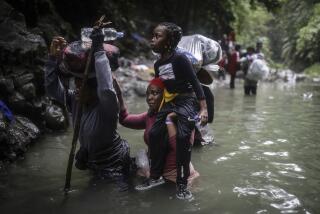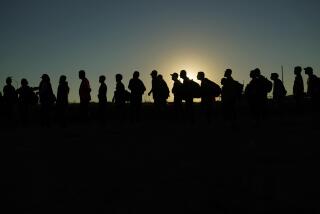Editorial: U.S. takes common sense steps to stem Central American migration

Democratic Representative from Illinois Luis Gutierrez calls on President Obama to grant temporary protected status to some individuals already ordered to be deported, on Jan. 8.
The Northern Triangle countries of Central America — El Salvador, Honduras and Guatemala — have long been among the most unstable and violent areas in the Western Hemisphere. Three decades after civil wars and insurrections roiled the region, murderous street gangs now control entire neighborhoods, drug smugglers work with brutal abandon, corruption makes justice elusive and, according to a 2014 ruling by a U.S. immigration judge, a chauvinistic culture in Guatemala leaves women prey to domestic violence with limited protection from police. Those conditions have combined over recent years to persuade about 10% of the countries’ 30 million inhabitants to flee their homes, according to the Council on Foreign Relations. Tens of thousands of unaccompanied minors and mothers with children continue to move north in hopes of gaining permission to stay in the U.S.
The Obama administration has treated that human flow primarily as an immigration and border security problem, and has sought to repatriate quickly those who fail to make the case that they qualify for asylum. Advocates raise legitimate concerns about asylum-seekers being denied a full and fair hearing under the “rocket docket” approach taken by an immigration court system already overwhelmed with hundreds of thousands of cases, many of which involve people who can’t find or afford lawyers. The new federal budget adds 55 immigration judges to the Executive Office for Immigration Review, bringing the total to 374 positions. While the new staffing level is lower than some critics think sufficient, it should help relieve some of the pressure.
But countering the out-migration of Central Americans requires more than just immigration enforcement here, or in Mexico for that matter. Under pressure from the Obama administration, Mexico has tightened its southern border to choke off the flow near the source. Because this effort did nothing to address the factors compelling people to leave their homes, it managed to reduce migration only for a matter of months — until resourceful and desperate people found other routes. Now the number of unaccompanied minors and mothers with children reaching the U.S. border is again on the rise.
In an effort to relieve more of the pressure within the region, the federal budget for fiscal 2016 includes $750 million — more than a third above the last budget — to improve conditions in Honduras, Guatemala and El Salvador in an effort to reduce the impetus to leave. The legislation tries to prevent the money from disappearing into corrupt coffers, directing it to be spent on improving the region’s economy, reducing poverty, combatting drug trafficking and gangs, and creating stronger and more transparent local governance, as well as helping those deported from the U.S. resettle in their home countries.
Meanwhile, the Obama administration also announced this month that it will work with the United Nations High Commissioner for Refugees to give those who feel they qualify for protection under international refugee laws a chance to make their case in their home countries or nearby. While details such as where to put the processing centers have not been worked out, the system would resemble those used to screen potential refugees in the Middle East and other unstable parts of the world. After investigating applicants’ claims, people the UNHCR deems eligible for refugee status would be referred to potential resettlement countries. Historically, most such referrals are made to the U.S., where the applicants would undergo additional screening before being accepted.
Making it easier for the fearful to seek protection closer to home could reduce the number of people turning to human smugglers and attempting the dangerous overland journey. At the same time, the administration has agreed to take in more of those fleeing the region who qualify as refugees. Secretary of State John Kerry recently announced that the government will increase by an unspecificed amount the number it will accept from Central America this fiscal year; the current cap is 3,000 of the 85,000 worldwide refugee slots. Considing the low overall limit, even a big increase in the region’s cap would be insufficient to resolve the problem, as is the $750 million in aid. But it’s a start.
Follow the Opinion section on Twitter @latimesopinion and Facebook
More to Read
A cure for the common opinion
Get thought-provoking perspectives with our weekly newsletter.
You may occasionally receive promotional content from the Los Angeles Times.






